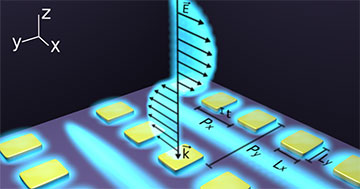
An artist’s view of a metasurface consisting of a rectangular array of gold nanostructures generating plasmonic surface lattice resonances. [Image: Yaryna Mamchur]
Recent research in plasmonics and metamaterials has led to exciting developments in the field of nanophotonics. However, the transition to practical applications like biosensing, spectroscopy and nanolasing remains hindered by low quality factors (Q factors) as a result of the large Ohmic losses intrinsic to all metals.
In a new study, a team of researchers has pushed the limits of the Q factor in a special type of plasmonic metasurface to nearly 2400, which is at least 10 times larger than previously reported values (Nat. Commun., doi: 10.1038/s41467-021-21196-2). The work could overturn a long-held notion that metal plasmonic nanostructures demonstrate losses too great for real-world devices.
Leveraging a collective response
OSA early-career member Orad Reshef and his colleagues had previously fabricated metasurfaces with periodic arrays of nanoparticles that support optical resonances called surface lattice resonances (SLRs). SLR-based metasurfaces have much higher Q factors than traditional metasurfaces—which are based on individual nanostructures that exhibit localized surface plasmon resonances (LSPRs)—due to a collective response of the arrays.
“Honestly, we were just very curious to see how high the Q factor could be in a plasmonic metasurface,” said Reshef, a Banting postdoctoral fellow at the University of Ottawa, Canada. “We [wanted to see how much it] could be improved, with an eye towards perhaps implementing some application in nonlinear optics down the road.”
While the Q factors associated with LSPRs are typically less than 10, the highest experimentally observed Q factor in an SLR-based metasurface to date was 430. Saad Bin-Alam, the lead author of the current work, quickly obtained values larger than 500, which both surprised him and spurred a line of research to figure out why his Q factor jumped up so dramatically compared with other groups.
Record-breaking Q factor
Bin-Alam and Reshef iterated on several different design parameters to identify the limitations of past SLR-based metasurfaces. They discovered that the nanostructure geometry, array size and spatial coherence of the probing light source had the greatest influence on the Q factor. In the end, the researchers demonstrated a plasmonic metasurface with a Q factor of 2340 in the telecommunication C band.
“The Q we report—of roughly 2400—is one of the highest reported in any metasurface, regardless of platform,” said Reshef. “The fact that it was obtained in a metasurface that featured plasmonic particles really turns the conventional wisdom that metals should be avoided in photonics on its head.”
He believes that, with the right approach, the Q factor could still be further improved. Now that a major hurdle of plasmonic nanostructures has been overcome, the researchers foresee potential applications such as narrow-band notch filters, nanolasers, and parametric downconversion for heralded quantum sources.
